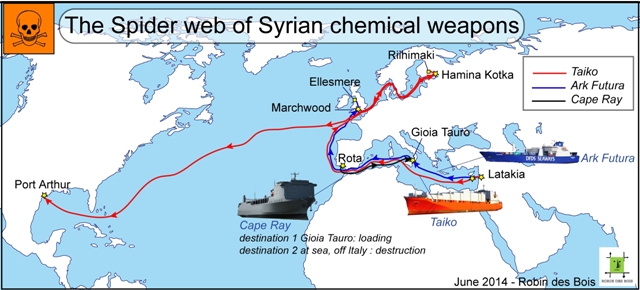Since the beginning of the year two vessels, loaded with agents for chemical weapons, have been rocking and rolling in the Eastern Mediterranean Sea. There exact location is confidential. The Ark Futura is a 180 meter long RoRo ship operating under the Danish flag. The crew is multinational. The Taiko is a 262 meter long RoRo ship operating under the Norway International flag. In the case of a collision or fire this type of vessel, which can be likened to a floating parking lot, is very vulnerable and will sink quickly.
These ships are part of the maritime logistics, put in place by the Organization for the Prohibition of Chemical Weapons (OPCW), for the destruction Syrian of chemical weapons. June 30 2014 was the initial date set for the full elimination. It was also originally planned that the Taiko and the Ark Futura would be loaded with the totality of the chemical agents before leaving the Eastern Mediterranean Sea.
To date, around 8 % of the chemical agents remain in Syria.
However, according to the latest information, the RoRo Taiko is heading towards Finland to deliver around 500 tonnes of priority 2 chemicals at Hamina Kotka port. They will then be transported around 60km by road or rail to the Ekokem Riihimäki waste treatment plant. The Taiko will then cross the Atlantic to Port Arthur Texas to offload the rest of her chemical burden where they will be incinerated. The Taiko with her military escorts will probably traverse the Bay of Biscay by the end of the week.
In the meantime, the Ark Futura is still waiting in the Eastern Mediterranean in international water. She frequently touches base at the Syrian Port of Latakia to receive chemical packages. Following the last delivery the roadmap for the Danish roro Ark Futura will be to transship, at the Italian port Gioia Tauro, 560 tonnes of priority 1 chemicals, to the American floating factory the Cape Ray, the third roro in the affair. Then the Ark Futura will probably sail to Marchwood Military Port near Southampton in the United Kingdom. The last 150 tonnes of priority 1 chemical agents will then be transported by road or rail to the Ellesmere Port High Temperature Incinerator near Liverpool.
The action plan for the destruction of Syrian chemical weapons keeps running behind schedule and therefore becomes more complicated and accumulates more risks. For 6 months, two single hull commercial vessels have been used as floating storage for hazardous substances on the Mediterranean Sea. When the Cape Ray, anchored for 5 months at a Spanish military base, enters onto the stage, the Mediterranean will be the setting of a world first, the destruction of chemical weapons at sea. The current scenario is that the chemicals will be treated onboard the Cape Ray off the Italian coast in international waters. Depending on the conditions at sea the Cape Ray will have to suspend all industrial activities.
Taking into account the delays and the time needed for the first test runs and overall treatment the operation will continue in mid-September when the weather conditions will start to deteriorate. Consequently, Robin des Bois is asking, yet again, the OPCW and the United Nations to change the programme and to find a safer solution on land for the destruction of all Syrian chemical weapons.
 Imprimer cet article
Imprimer cet article










